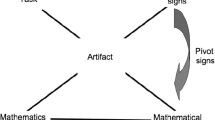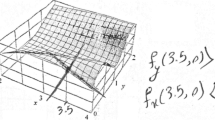ABSTRACT
This paper reports on different underlying structures of the derivative schema of three undergraduate students that were considered to be at the trans level of development of the derivative schema (action–process–object–schema). The derivative schema is characterized in terms of the students’ ability to explicitly transfer the relationship between a function and its first derivative to the derivative function and the second derivative. This conscious shift of properties of derivatives is differently manifested by the students in the trans level of development of the derivative schema and can be considered evidence of the different characteristics of the thematization of derivative schema. From here we suggest that there are different underlying structures in the constructed schema due to the consciousness in which students use the relations between a function and its derivative.
Similar content being viewed by others
References
Apostol, T. M. (1982). Análisis Matemático. Reverté, S.A.
Asiala, M., Cottrill, J., Dubinsky, E., & Schwingendorf, K. (1997). The development of students’ graphical understanding of the derivative. Journal of Mathematical Behavior, 16(4), 399–431.
Baker, B., Cooley, L., & Trigueros, M. (2000). A calculus graphing schema. The Journal for Research in Mathematics Education, 31(5), 557–578.
Berry, J. S., & Nyman, M. A. (2003). Promoting students’ graphical understanding of the calculus. Journal of Mathematical Behavior, 22, 481–497.
Campbell, R. L. (2001). Reflecting abstraction in context. Editor’s introduction to J. Piaget, Studies in reflecting abstraction [R. L. Campbell, Ed., Trans] (pp. 1–27). Sussex, UK: Taylor & Francis.
Clark, J. M., Cordero, F., Cottrill, J., Czarnocha, B., DeVries, D. J., St. John, D., Tolias, G., et al. (1997). Constructing a schema: The case of the chain rule. Journal of Mathematical Behavior, 14(4), 345–364.
Clement, J. (2000). Analysis of clinical interviews: Foundations and model viability. In A. E. Kelly & R. A. Lesh (Eds.), Handbook of research design in mathematics and science education (pp. 547–590). Mahwah, NJ: Lawrence Erlbaum Associates.
Confrey, J., & Costa, Sh. (1996). A critique of the selection of “mathematical objects” as a central metaphor for advanced mathematical thinking. International Journal of Computer for Mathematical Learning, 1, 139–168.
Cooley, L., Trigueros, M., & Baker, B. (2003). Thematization of the calculus graphing schema. In N. Pateman, B. Dougherty, & J. Zilliox (Eds.), Proceedings of the 27th annual meeting of the International Group for the Psychology of Mathematics Education, 2 (pp. 57–64). Honolulu, HI: University of Hawaii.
Cooley, L., Trigueros, M., & Baker, B. (2007). Scheme thematization: A framework and an example. Journal for Research in Mathematics Education, 38(4), 370–392.
Cottrill, J., Dubinsky, E., Nichols, D., Schwingendorf, K., Thomas, K., & Vidakovic, D. (1996). Understanding the limit concept: Beginning with a coordinated process scheme. The Journal for Mathematical Behavior, 15, 167–192.
Davis, G. E., & Tall, D. O. (2002). What is a scheme? In D. Tall & M. Thomas (Eds.), Intelligence, learning and understanding. A tribute to Richard Skemp (pp. 131–150). Flaxton, Queensland, Australia: Post Pressed.
Dörfler, W. (2002). Formation of mathematical objects as decision making. Mathematical Thinking and Learning, 4(4), 337–350.
Dubinsky, E. (1991a). Reflective abstraction in advanced mathematical thinking. In D. Tall (Ed.), Advanced mathematical thinking (pp. 95–126). Dordrecht, The Netherlands: Kluwer.
Dubinsky, E. (1991b). Constructive aspects of reflective abstraction in advanced mathematics. In L. P. Steffe (Ed.), Epistemological foundations of mathematical experiences (pp. 160–202). New York: Springer.
Dubinsky, E. (1996). Aplicación de la perspectiva piagetiana a la educación matemática universitaria. Educación Matemática, 8(3), 24–41.
Dubinsky, E., Weller, K., McDonald, M. A., & Brown, A. (2005). Some historical issues and paradoxes regarding the concept of infinity: An APOS analysis: Part 1/2. Educational Studies in Mathematics, 58(60), 335–359. 253–266.
Edwards, B., Dubinsky, E., & McDonald, M. A. (2005). Advanced mathematical thinking. Mathematical Thinking and Learning, 7(1), 15–25.
Goldin, G. (2000). A scientific perspective on structured, task-based interviews in mathematics education research. In A. E. Kelly & R. A. Lesh (Eds.), Handbook of research design in mathematics and science education (pp. 517–546). Mahwah, NJ: Lawrence Erlbaum Associates.
Habre, S., & Abboud, M. (2006). Students’ conceptual understanding of a function and its derivate in an experimental calculus course. Journal of Mathematical Behavior, 25, 57–72.
Hähkiöniemi, M. (2006). Associative and reflective connections between the limit of the difference quotient and limiting process. Journal of Mathematical Behavior, 25, 170–184.
Harel, G., Selden, A., & Selden, J. (2006). Advanced mathematical thinking. In A. Gutierrez & P. Boero (Eds.), Handbook of research on the psychology of mathematics education (pp. 147–172). Rotterdam, The Netherlands: Sense.
Harel, G., & Sowder, L. (2005). Advanced mathematical-thinking at any age: Its nature and its development. Mathematical Thinking and Learning, 7, 27–50.
Mason, J., & Jonston-Wilder, S. (2004). Fundamental constructs in mathematics education. London: Routhledge Falmer–The Open University.
Meel, D. E. (2003). Modelos y teorías de la comprensión matemática: Comparación de los modelos de Pirie y Kieren sobre la evolución de la comprensión matemática y la teoría APOE. Revista Latinoamericana de Investigación en Matemática Educativa, 6(3), 221–271.
Piaget, J. (1977). The development of thought: Equilibration of cognitive structures. New York: Viking.
Piaget, J. (2001). Studies in reflecting abstraction. Philadelphia: Taylor and Francis.
Piaget, J., & García, R. (1989). Psicogénesis e historia de la ciencia. Madrid, Spain: Siglo Veintiuno Editores, S.A.
Sánchez-Matamoros G. (2004). Análisis de la comprensión en los alumnos de Bachillerato y primer año de la Universidad sobre la noción matemática de derivada (desarrollo del concepto). Doctoral dissertation. Universidad de Sevilla. España.
Sánchez-Matamoros G., García M., & Llinares S. (2006). El desarrollo del esquema de derivada. Enseñanza de las Ciencias, 24(1), 85–98.
Sánchez-Matamoros, G., García, M., & Llinares, S. (2008). La comprensión de la derivada como objeto de investigación en Didáctica de la Matemática. Revista Latinoamericana en Matemática Educativa, 11(2), 267–296.
Simon, M. A., Tzur, R., Heinz, K., & Kinzel, M. (2004). Explicating a mechanism for conceptual learning: Elaborating the construct of reflective abstraction. Journal for Research in Mathematics Education, 35(5), 305–329.
Skemp, R. R. (1986). The psychology of learning mathematics (2nd ed.). Middlesex, England: Penguin.
Spivak, M. (1974). Calculus. Reverté, S.A.
Steffe, L. P. (1983). Children’s algorithms as schemes. Educational Studies in Mathematics, 14, 109–125.
Steffe, L. P. (1991). Epistemological foundations of mathematical experiences. New York: Springer.
Thompson, P. W. (2002). Didactic objects and didactic models in radical constructivism. In K. Gravemeijer, R. Lehrer, B. Van Oers, & L. Verschaffel (Eds.), Symbolizing, modelling, and tool use in mathematics education (pp. 197–220). Dordrecht, The Netherlands: Kluwer.
Tzur, R., & Simon, M. (2004). Distinguishing two stages of mathematics conceptual learning. International Journal of Science and Mathematics Education, 2, 287–304.
Vergnaud, G. (1990). La theorie des champs conceptuels. Recherches en Didactique des Mathematiques, 10, 13.
Zandieth, M. (1997). The evolution of student understanding of the concept of derivative. Doctoral dissertation, Oregon State University.
Author information
Authors and Affiliations
Corresponding author
Rights and permissions
About this article
Cite this article
García, M., Llinares, S. & Sánchez-Matamoros, G. CHARACTERIZING THEMATIZED DERIVATIVE SCHEMA BY THE UNDERLYING EMERGENT STRUCTURES. Int J of Sci and Math Educ 9, 1023–1045 (2011). https://doi.org/10.1007/s10763-010-9227-2
Received:
Accepted:
Published:
Issue Date:
DOI: https://doi.org/10.1007/s10763-010-9227-2




